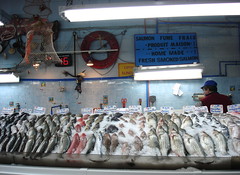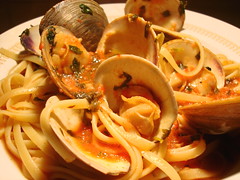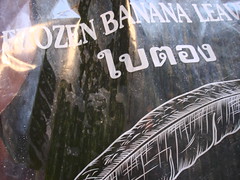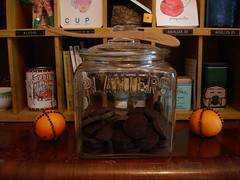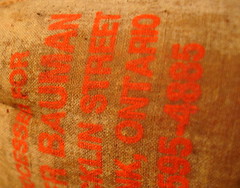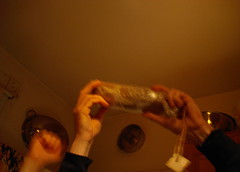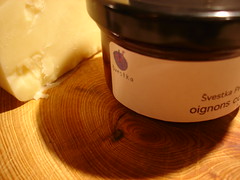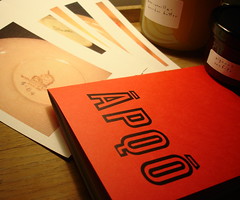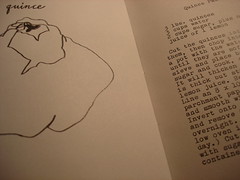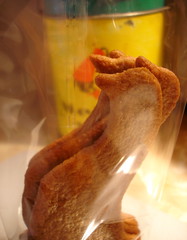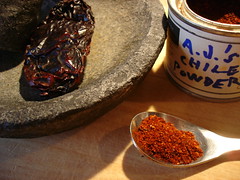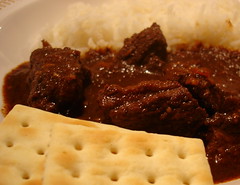Out With 2006, With Love (rev. ed.)
Drum roll, please.
Print:
Bill Buford, Heat and "Talking Turkey," The New Yorker
Ralph Rummey, The Consul
Richard Olney, The French Menu Cookbook
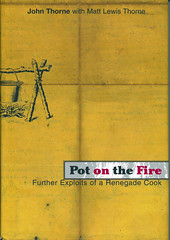 fig. a: Pot On The Fire
fig. a: Pot On The Fire
John Thorne and Matt Lewis Thorne, Pot On The Fire
Michael Ondaatje, The Conversations
Elisabeth Prueitt and Chad Robertson, Tartine
Edward A. Bunyard, The Anatomy of Dessert
Martin Picard & co., Au Pied de Cochon: The Album
Tom Bissell, "The Secret Mainstream: Contemplating the Mirages of Werner Herzog," Harper's
A.J. Downing, Fruit and Fruit Trees of America
Jeff Cox, "Olympia Oysters," The Art of Eating
Anya von Bremzen, The New Spanish Table
Karel Čapek, The Gardener's Year
Calvin Trillin, "Alice, Off the Page," The New Yorker
Pete Wells, "The World's Best Chocolate," Food & Wine
Rowan Jacobsen, "A Taste By Any Other Name: Umami Comes West," The Art of Eating
Tad Friend, "The Playhouse," The New Yorker
Bob Sloan, "Mario's Excellent Adventure," Gourmet
Edward Behr, "Questioning Myself," The Art of Eating
Beverley Nichols, Down the Kitchen Sink
Bruce Chatwin, In Patagonia
Bill Wasik, "My Crowd," Harper's
Song:
Joanna Newsom, Ys
Bill Fay Group, Tomorrow Tomorrow and Tomorrow
v/a, Love is Love
Washington Phillips, What Are They Doing in Heaven Today?
v/a, Last Kind Words
Vashti Bunyan, live at La Tulipe
Ratatat, "Wildcat"
Johnny Cash, American V: A Hundred Highways
Luiz Bonfá, Solo in Rio, 1959
Destroyer, Destroyer's Rubies
v/a, And to the Disciples That Remain
 fig. b: The Letting Go
fig. b: The Letting Go
Bonnie 'Prince' Billy, The Letting Go
Blind Blake, Rope Stretchin' Blues
Pavement, Wowee Zowee! (Sordid Sentinels edition)
v/a, Big Apple Rappin': The Early Days of Hip-Hop Culture in New York City
The Kinks, Muswell Hillbillies and Village Green Preservation Society
v/a, Jamaica to Toronto: Soul, Funk and Reggae 1967-1979
Stuart A. Staples, Leaving Songs, Lucky Dog Recordings 03-04, and live at La Sala Rossa
Brightblack Morning Light, s/t
P.G. Six, Music From The Sherman Box Series and Other Works
The Modern Lovers, Precise Modern Lovers Order
Moving Images:
The Queen, Frears
Broken Flowers, Jarmusch
The New World, Malick
Kings of the Sky, Stratman
Le Samourai and Un Flic, Melville
Caché, Haneke
Grizzly Man, Lessons of Darkness and The Great Ecstasy of Woodcarver Steiner, Herzog
 fig. c: Sheila Sim in A Canterbury Tale
fig. c: Sheila Sim in A Canterbury Tale
A Canterbury Tale, Powell and Pressburger
Vernon, Florida, Morris
Little Miss Sunshine, Dayton and Faris
The Departed, Scorsese
Volver, Almadovar
Chain, Cohen
Trouble in Paradise and Ninotchka, Lubitsch
The French Chef (feat. Julia Child)
The Wire (season 3)
Restos:
Bottega
Ange & Ricky
M Sur Masson
Tapeo
Bombay Choupati
BU
Mister Spicee
Jamie Kennedy Wine Bar (Toronto)
Randy's Bakery (Toronto)
Chick & Ruth's (Annapolis, MD)
Ocean Odyssey (Cambridge, MD)
Momofuku (NYC)
Rai Rai Ken (NYC)
Steve's Authentic Key Lime Pies (NYC)
Franny's (NYC)
Misc:
making fresh pasta
Cosse Maisonneuve, La Fage, Cahors 2002
Saturday-afternoon bread
1-qt bean pot
homemade gravlax
12-gauge chili
LeNell's Ltd. (NYC)
Corner Creek Reserve Bourbon Whiskey
Roquefort Baragnaude
MO-style ribs
Au Pied de Cochon: The Album launch lunch and launch party
Darjeeling Samabeong DJ-1
Abner Bauman summer sausage
The Murray Bay
Pear Mostarda
BLiS Bourbon Barrel Matured Organic Maple Syrup
Blackberry Acid
puerco asado a la Cubana
Huguenot Torte
Muscat honey
our Le Creuset tea pot (not because it's a Le Creuset necessarily, more because of its classic styling, its classic size (6+ cups), and the fact that it actually pours nicely)
Carolina-style pulled pork sandwiches
finishing Clarissa before the year is out
R.I.P.:
R.W. Apple, Jr.
am/km

